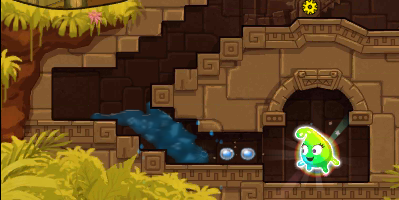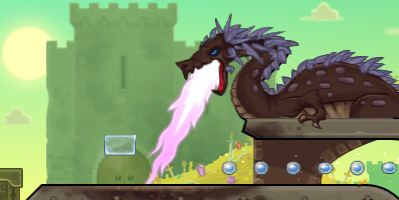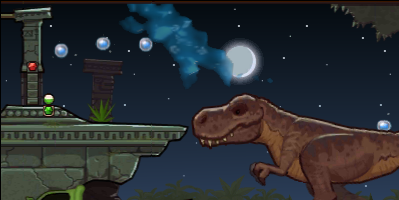
The original Fluidity is still one of the best original titles to appear on WiiWare, so when I first heard about a 3DS eShop sequel being planned, I was certainly looking forward to it. That sequel, Fluidity: Spin Cycle, arrived in late December. Some cosmetic changes have been made that make the game appear like some sort of mascot platformer if you don’t see any actual gameplay images, but rest assured: this is still the same splashing, freezing, and lightning-blasting Fluidity puzzle-platforming.
As before, you begin with just your water form and will eventually unlock ice and cloud forms. The 3DS’s inherent gyro sensor does most of the work for you here as you pour your water and slide your cube along hills and other obstacles. Jumping and changing altitude as a cloud are now governed by the L/R buttons instead of shaking or tilting, and you can use either button inputs or touch screen controls to activate various devices and abilities.

Almost all of the abilities of the original game return, although the cloud’s suction has been replaced by an inherent static attraction to any balloons you might want to bring with you, and the water can only spout at specific devices. Sometimes those devices will involve guiding various objects to designated locations, and in a pleasant fix, you no longer are forced to start over should one of those objects become lost to a hazard; it simply respawns and you get to take another shot at it. You can still die by running out of water (tip: avoid fire and sand), but now accidentally watching a gear tumble into lava isn’t nearly as painful. The overall goal hasn’t changed either, as you are still trying to find Rainbow Drops to free an enchanted book from the influence of dark goop.
What has changed, however, is the layout of the game. Where the original took place in four interesting Metroidvania-style worlds filled with secrets and tantalizing obstacles, Spin Cycle is broken down into sixty bite-sized stages (fifteen each in four different themed worlds). This shift was probably made to accommodate a more episodic, handheld-friendly play schedule, but does make the game feel less… well, fluid. Each stage has a single Rainbow Drop as your ultimate goal, with one puzzle piece hidden somewhere that will unlock that world’s playroom if you find all fifteen.

The shift to a stage-based layout has also introduced an obnoxious star-rating system on each level. Most of your rating will come from how many water droplets you collected (and have remaining) once you finally finish the stage. But one star (out of five) will depend on whether or not you clear the stage before a graphical timer counts down. A timer with an really obnoxious alarm, that will ruin your play experience every time and you will quickly come to despise. Some of the puzzles can be incredibly tricky or demand precise timing, so putting that on a clock seems like an incredibly poor choice. Fortunately there doesn’t appear to be any advantage gained by earning five stars on each level, so other than the obtrusive alarm this aspect is really only a concern for the obsessive completionists.
Still, the format change was not entirely for the worse. Thanks to being isolated stages rather than larger worlds, a few levels have… different gravity. Specifically, these stages can be rotated a full 360, thus giving Spin Cycle its subtitle. While these stages are very cool and challenging, there are a couple of issues that probably needed to be ironed out first. Try interacting with the touch screen and buttons while holding your 3DS upside down or book-style, for instance; it’s harder than you think, especially when you need to do so with precision timing. Not that there would be any good way to handle both actions, so I can’t really harp on that too much.
Disappointing but defensible deviations from the original aside, Spin Cycle is, as I mentioned, still Fluidity. Using the gyro to move around is still fun and mostly intuitive, and the puzzles are still fairly challenging. I still prefer the WiiWare version – and while playing this I realized how incredibly awesome a Fluidity game would be on the Wii U GamePad, which someone needs to make happen immediately – but for a portable version Spin Cycle delivers just about everything that made the original great, even if in a somewhat different form. And hey, changing form is part of what Fluidity is all about anyway.
Pros: Full-rotation levels add an interesting twist to already-great Fluidity gameplay
Cons: Loss of Metroidania-style worlds; most annoying timer ever



















